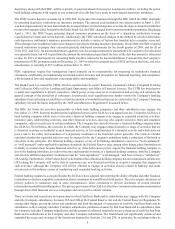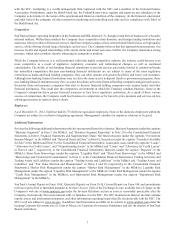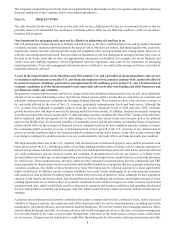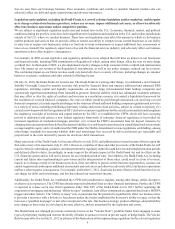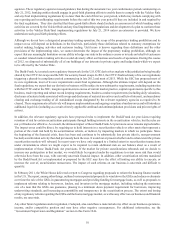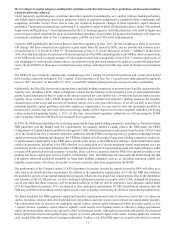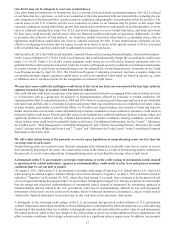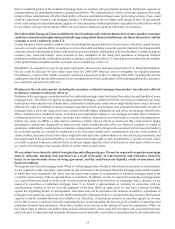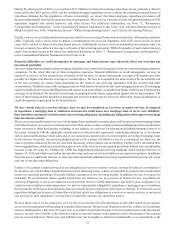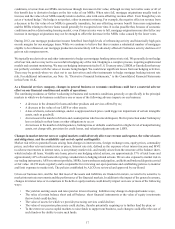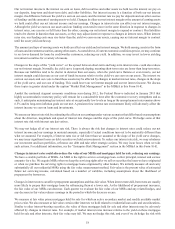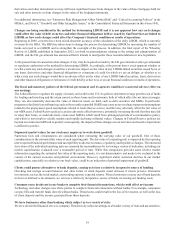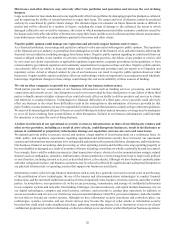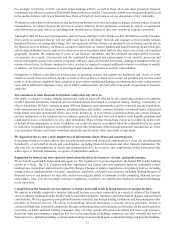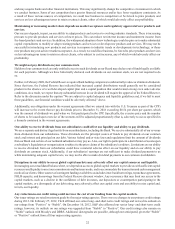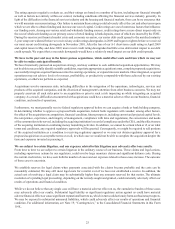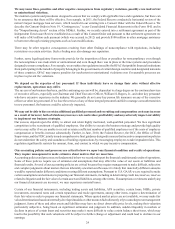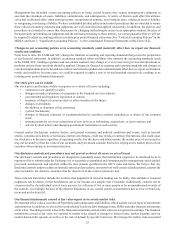SunTrust 2012 Annual Report Download - page 31
Download and view the complete annual report
Please find page 31 of the 2012 SunTrust annual report below. You can navigate through the pages in the report by either clicking on the pages listed below, or by using the keyword search tool below to find specific information within the annual report.15
During the third quarter of 2012, we recorded a $371 million provision for mortgage repurchase losses, primarily related to
loans sold to the GSEs prior to 2009, and the resulting mortgage repurchase reserve reflects the estimated incurred losses on
repurchase demands for this population of loans. Accordingly, we expect that future mortgage repurchase provisions will
decrease substantially from levels experienced in recent quarters. However, our estimate of losses is highly dependent on GSE
repurchase requests and related behavior, and other factors. For additional information, see Note 17, “Reinsurance
Arrangements and Guarantees,” to the Consolidated Financial Statements in this Form 10-K, and the following sections of
MD&A in this Form 10-K–"Noninterest Income”, "Other Nonperforming Assets”, and "Critical Accounting Policies."
Finally, we have received indemnification requests related to our servicing of loans owned or insured by other parties, primarily
GSEs. Typically, such a claim seeks to impose a compensatory fee on us for departures from GSE service levels. In most
cases, this is related to delays in the foreclosure process. Additionally, we have received indemnification requests where an
investor or insurer has suffered a loss due to a breach of the servicing agreement. While the number of such claims has been
small, these could increase in the future. See additional discussion in Note 17, “Reinsurance Arrangements and Guarantees,”
to the Consolidated Financial Statements in this Form 10-K.
Financial difficulties or credit downgrades of mortgage and bond insurers may adversely affect our servicing and
investment portfolios.
Our servicing portfolio includes certain mortgage loans that carry some level of insurance from one or more mortgage insurance
companies. To the extent that any of these companies experience financial difficulties or credit downgrades, we may be
required, as servicer of the insured loan on behalf of the investor, to obtain replacement coverage with another provider,
possibly at a higher cost than the coverage we would replace. We may be responsible for some or all of the incremental cost
of the new coverage for certain loans depending on the terms of our servicing agreement with the investor and other
circumstances. Similarly, some of the mortgage loans we hold for investment or for sale carry mortgage insurance. If a mortgage
insurer is unable to meet its credit obligations with respect to an insured loan, we might incur higher credit losses if replacement
coverage is not obtained. We also have investments in municipal bonds that are guaranteed against loss by bond insurers. The
value of these bonds and the payment of principal and interest on them may be adversely affected by financial difficulties or
credit downgrades experienced by the bond insurers.
We face certain risks as a servicer of loans. Also, we may be terminated as a servicer or master servicer, be required
to repurchase a mortgage loan or reimburse investors for credit losses on a mortgage loan, or incur costs, liabilities,
fines and other sanctions if we fail to satisfy our servicing obligations, including our obligations with respect to mortgage
loan foreclosure actions.
We act as servicer and/or master servicer for mortgage loans included in securitizations and for unsecuritized mortgage loans
owned by investors. As a servicer or master servicer for those loans, we have certain contractual obligations to the securitization
trusts, investors or other third parties, including, in our capacity as a servicer, foreclosing on defaulted mortgage loans or, to
the extent consistent with the applicable securitization or other investor agreement, considering alternatives to foreclosure
such as loan modifications or short sales and, in our capacity as a master servicer, overseeing the servicing of mortgage loans
by the servicer. Generally, our servicing obligations are set by contract, for which we receive a contractual fee. However, the
costs to perform contracted-for services has been increasing, which reduces our profitability. Further, GSEs can amend their
servicing guidelines, which can increase the scope or costs of the services we are required to perform without any corresponding
increase in our servicing fee. Further, the CFPB has implemented national servicing standards which become effective on
January 10, 2014 and which may further increase the scope and costs of services which we are required to perform. In addition
there has been a significant increase in state laws that implement additional servicing requirements that increase the scope
and cost of our servicing obligations.
Further, if we commit a material breach of our obligations as servicer or master servicer, we may be subject to termination if
the breach is not cured within a specified period of time following notice, which can generally be given by the securitization
trustee or a specified percentage of security holders, causing us to lose servicing income. In addition, we may be required to
indemnify the securitization trustee against losses from any failure by us, as a servicer or master servicer, to perform our
servicing obligations or any act or omission on our part that involves willful misfeasance, bad faith or gross negligence. For
certain investors and/or certain transactions, we may be contractually obligated to repurchase a mortgage loan or reimburse
the investor for credit losses incurred on the loan as a remedy for servicing errors with respect to the loan. If we have increased
repurchase obligations because of claims that we did not satisfy our obligations as a servicer or master servicer, or increased
loss severity on such repurchases, we may have to materially increase our repurchase reserve.
We may incur costs if we are required to, or if we elect to re-execute or re-file documents or take other action in our capacity
as a servicer in connection with pending or completed foreclosures. We may incur litigation costs if the validity of a foreclosure
action is challenged by a borrower. If a court were to overturn a foreclosure because of errors or deficiencies in the foreclosure
process, we may have liability to the borrower and/or to any title insurer of the property sold in foreclosure if the required
process was not followed. These costs and liabilities may not be legally or otherwise reimbursable to us, particularly to the


